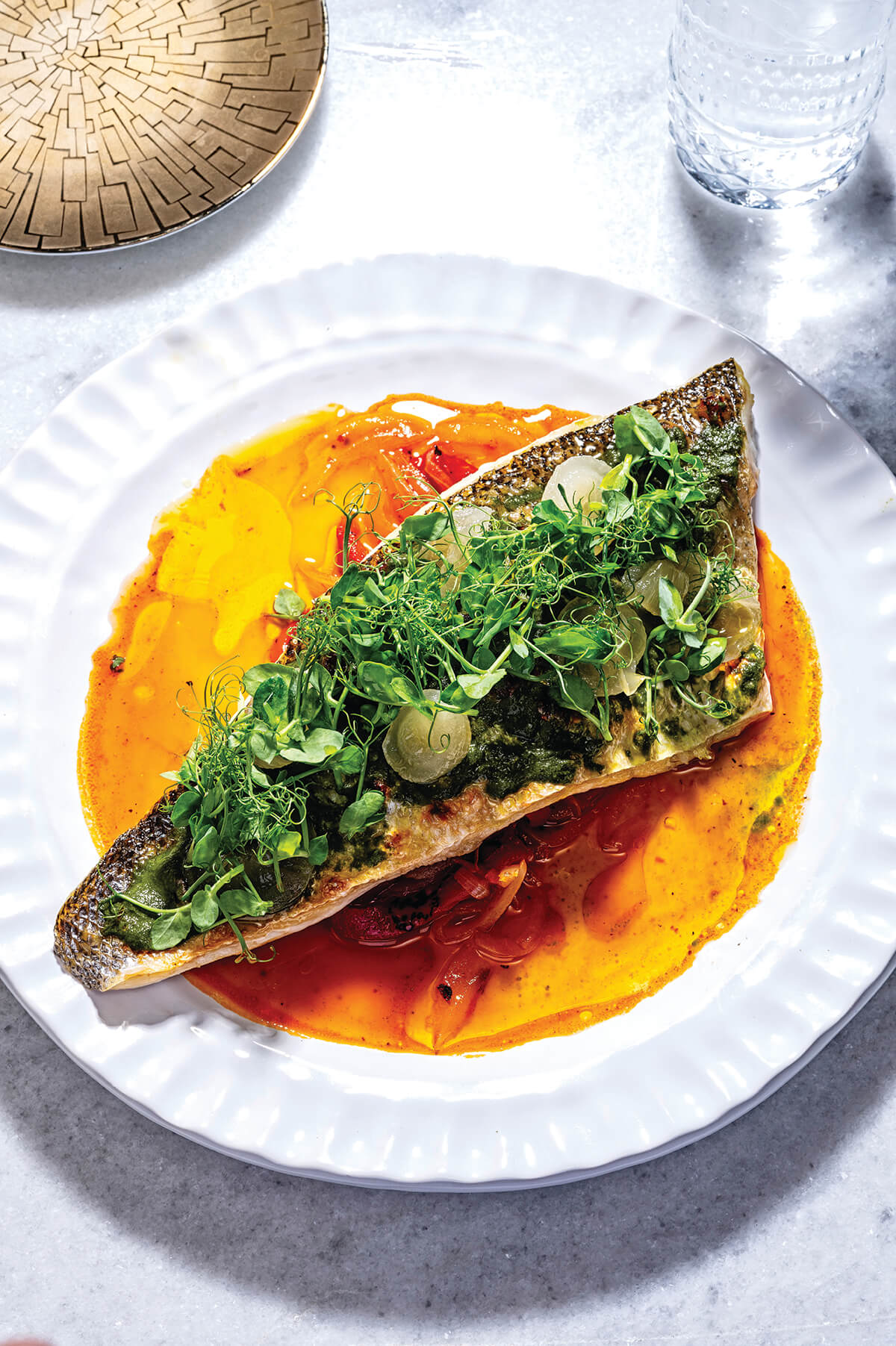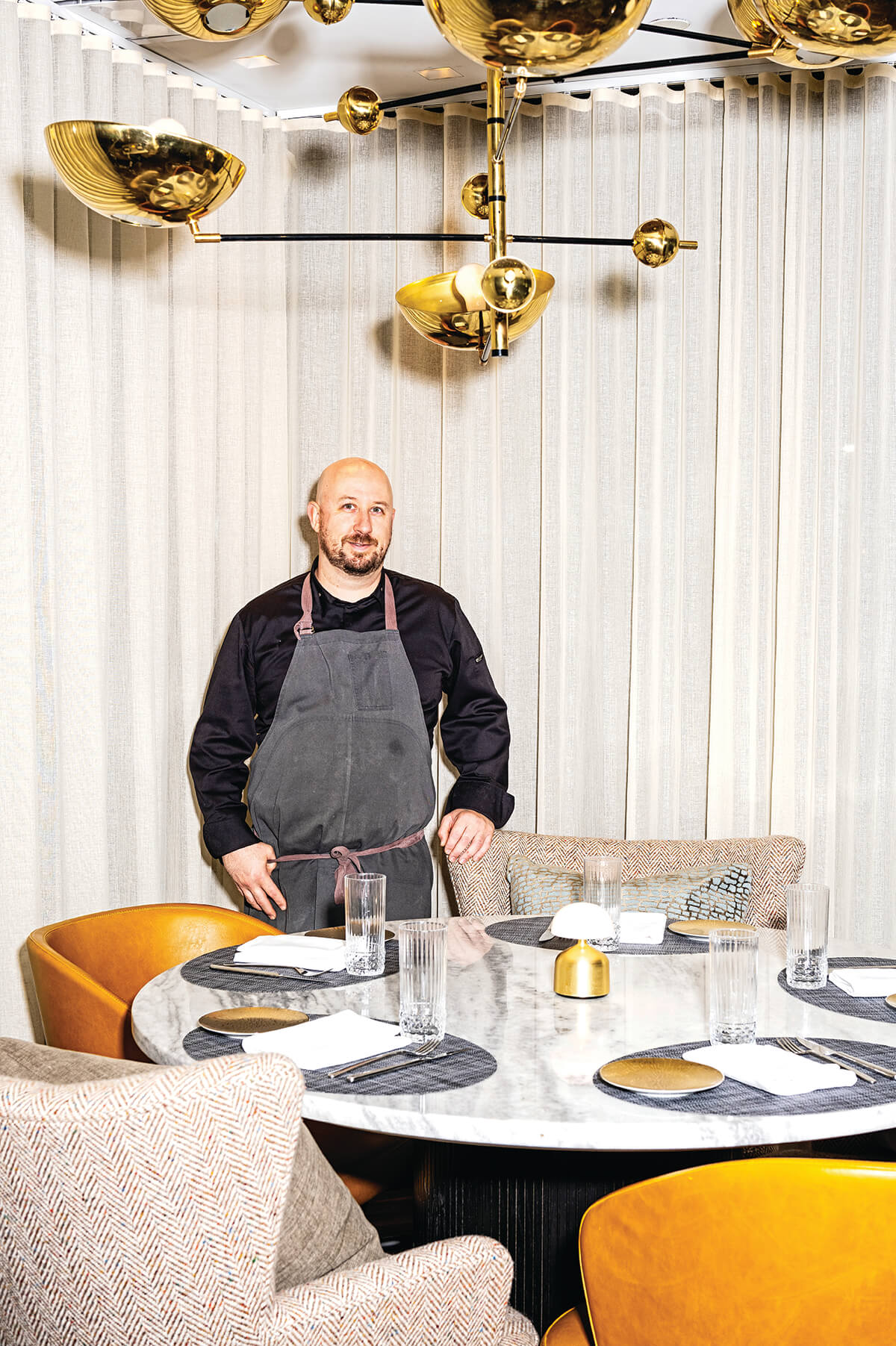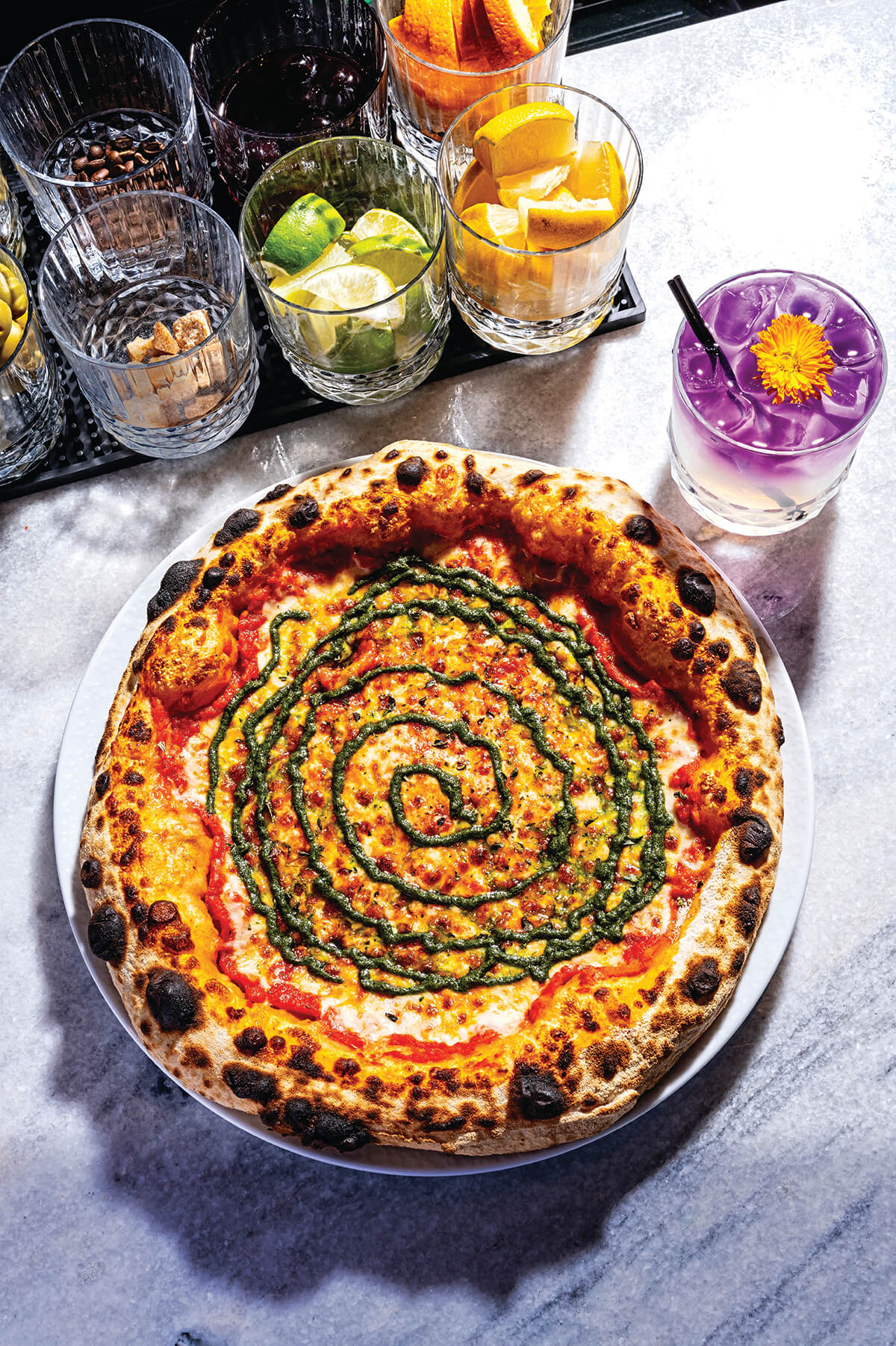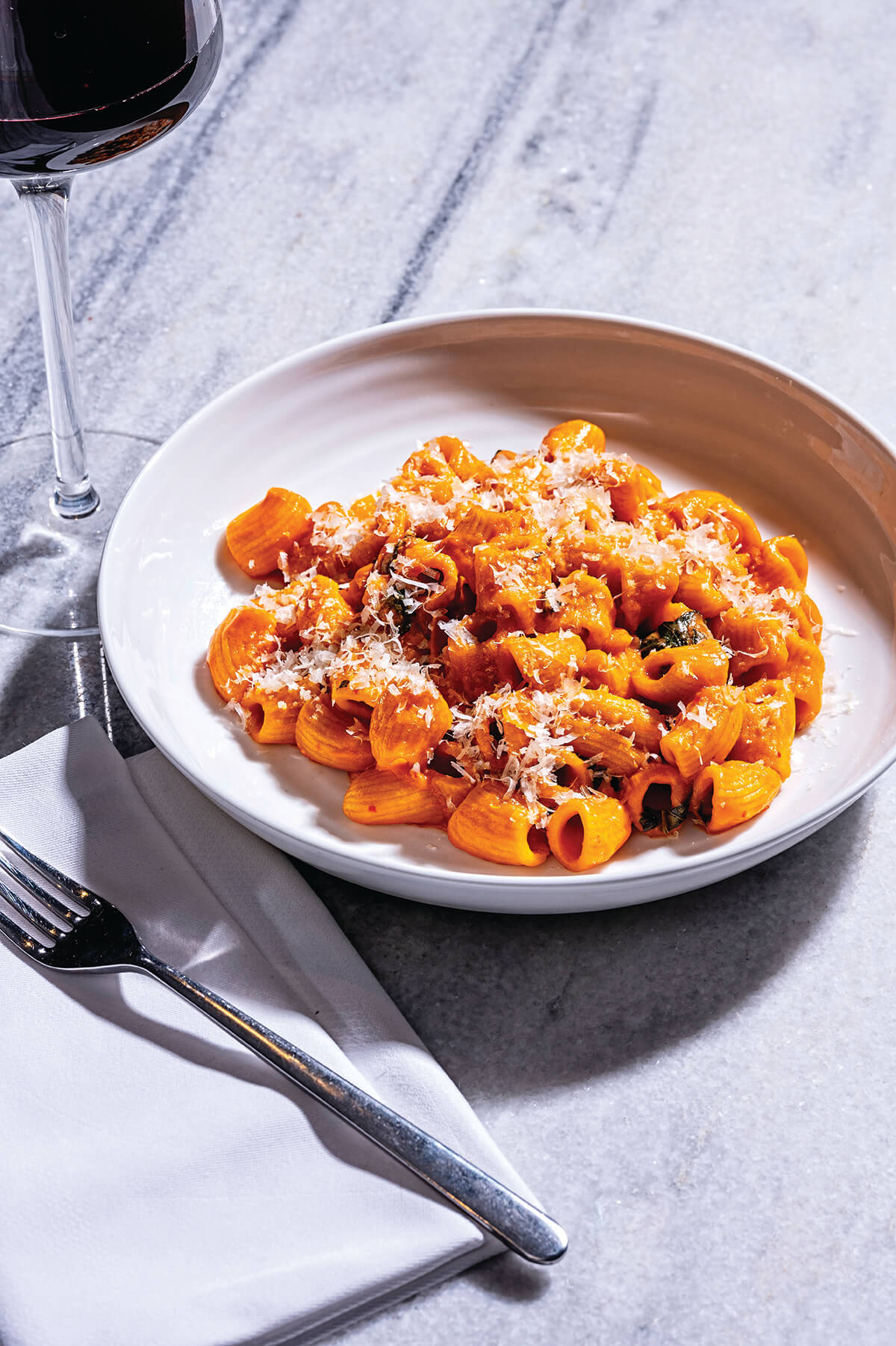Food & Drink
Review: Cece’s of Roland Park is a Buzzy Addition to Cross Keys Village
Chef Nick Sharpe has designed a Mediterranean menu that leans into local and seasonal ingredients, while also offering approachable appetizers, pizza and pasta, steaks, and seafood.

Petit Louis Bistro and Johnny’s aside, restaurants in Roland Park—the wealthy sylvan city enclave designed by Central Park’s famed landscape architect, Frederick Law Olmsted Jr.—have always been in short supply. Until now.
Thanks to the massive $30-million redevelopment of The Village of Cross Keys, six new eateries are in the works, the first of which is Cece’s of Roland Park, owned by The Cordish Companies.
With its spiffy dining room tricked out in luxe leather and tony tweed, tables alight with Rosenthal china, a glamorous racetrack oval bar, and a wall of windows that open onto a lush, landscaped, fire-pitted patio ringed by splashy shops, the 366-seat restaurant has been drawing patrons since opening in June.
The milieu is a fitting one for upper-crust Roland Park, one of America’s first “garden suburbs” and for Cross Keys itself, originally developed as a mixed use community by visionary James Rouse in 1965, though in recent years, the center had fallen on hard times.
Nearly 60 years later, if you rebuild it, they will come. As well-heeled diners stream in, everyone is seemingly a someone, a veritable who’s who of Baltimore. (On multiple visits, we spotted Ray Mitchner and his husband, Brian Comes, who owns fashion emporium Ruth Shaw. And Cece’s Instagram shows Maryland Gov. Wes Moore standing in the dining room with chef—and Frederick native—Nick Sharpe.)
Sharpe, who earned a Michelin star while working at Michael Mina Bellagio in Las Vegas, has designed a Mediterranean menu that leans into local and seasonal ingredients, while aiming to appeal to a diversity of diners and create, in his words, “an all-inclusive dining experience.”
The menu does, in fact, have something for everyone, with an approachable lineup of appetizers, pizza and pasta, steaks and seafood, as well as more composed plates.
“I don’t want stuff on the menu where you have to google the ingredients,” says Sharpe. “We want this to be a place where you can get food you feel comfortable eating every day of the week.”


And while we appreciate the simplicity of the menu, it can be a bit too minimalist, especially when it comes to descriptions of the dishes. On my first two trips, the dishes that arrived at the table were not quite what I was expecting—and servers did little to fill in the gaps.
An arugula salad with “peppers, Parmesan, and pine nuts” in lemon-oregano vinaigrette, for example, did not specify that the peppers were hot peppers, thus not only overwhelming the otherwise delicate salad but effectively obliterating it. I was told the linguini with “clams, parsley, Espelette,” was in a white sauce—a classic presentation—but was not warned that it was finished heavily with cream. Though tasty, it was way richer than I wanted. I left it virtually uneaten and when the server cleared, she whisked it away and said nothing. (Note to servers: Always ask if there was an issue so you can rectify it.)
Missteps aside, across my visits, I did enjoy many of the starters, including the warm carrot appetizer presented on a gorgeous gold ruffled plate with a drizzle of Greek yogurt and crumbled pistachios. The sweetness of the caramelized carrots roasted in the wood-burning oven combined well with spicy harissa and the tangy yogurt, flecked with herbs and spiced with cumin and coriander. The ‘nduja and chickpea spread (think hummus with a heat inducing Andouille sausage) served with rustic housemade pita was another standout and paired well with cocktails.
The pizzas coming out of that wood-burning oven are a welcome addition to the high-priced menu, and one of the more affordable options. They arrive nicely charred with a crisp Neapolitan-style crust. The classic cheese version with mozzarella, San Marzano tomato sauce, and swirls of basil purée was particularly pretty (and tasty) and the crust had a proper puff and was nicely charred. A pesto play on a Caesar with basil, avocado, and Parmesan on Little Gem lettuce was bright, bold, and satisfying enough to make a meal—I ordered it on every visit.


I also loved the simple bowl of mezze rigatoni spiked with Calabrian chile and coated in vodka sauce. The noodles had a pleasant chew and the tangy tomato sauce offered just the right punch of heat. A broiled branzino dish (sitting on a bed of fregola and tomatoes on my first visit and on a layer of heirloom tomatoes, crispy chickpeas, and Castelvetrano olives on another) was also flavorful, generously portioned, and perfectly cooked on two different visits. And the chicken Milanese—a thin, ultra crispy bone-in breast that’s brined, breaded, bathed in butter, and topped with lemon, cherry peppers, and tomatoes—was simple and sublime. A total standout.
Both the outdoor and indoor bars offer a convivial alternative to the formal dining room. On one visit, I enjoyed a negroni and appreciated the big ice monogrammed with “C” for Cece, named for one of the Cordishes’ grandchildren. On another trip, the Barr Hill martini was crisp and tasted of juniper, though sticker shock ensued when we got the bill—it was a whopping $30. When we inquired with our server, she said it was because we had ordered a top-shelf gin. But on a subsequent visit, when we inquired again, a manager told us there was a glitch in the system. It happens, though it’s notable that we actually believed the martini was $30 given the other menu prices.
Cece’s shows plenty of promise. With just a little more attention to detail, it can knock it, well, out of the park and become a true dining destination for Roland Park.